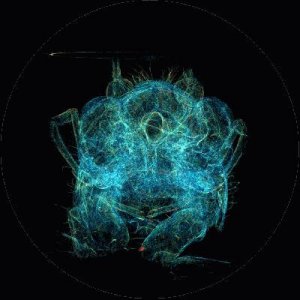
A 2D rendering of a three dimensional image of a cricket head composed using grid techniques.
The Center for High Performance Computing and Communication’s monthly seminar series continues at 1:30 p.m. November 9th in the Jefferson Conference Room (JEFF 124), when the dynamic Carl Kesselman of USC’s Information Sciences Institute will review the current status of Grid computing. The lecture will also be available at ISI via web links.
Grid computing is a technology that lets groups collaborate with one another by making it possible to share a wide variety of resources. Using the Internet as basic “wiring,” the Grid lets people share computing, storage, data, programs, and other resources just like the electric power grid allows people and power companies to share a power plant.The goal is to allow anyone with a computer to effectively integrate instruments, displays and computational and information resources over a variety of computer platforms.
Grid technologies for authentication, resource discovery, and so forth will soon make it possible for a professor teaching a class in (for example) environmental engineering, who wants his students to gets hands-on experience with environmental monitoring and modeling, to have the students call upon national resources as they undertake class projects.
Kesselman will discuss Grid activities as they relate to high performance and research computing with a focus on the role ISI is playing in these activities.
In recent years, Kesselman and Ian Foster of the University of Chicago and Argone National Laboratory have been developing basic grid tools and software in a project named Globus.
Kesselman and Foster’s Globus approach has won three major endorsements in recent weeks.
+ On September 24, NSF announced a $12.1 million program, the National Middleware Initiative, to create new Grid tools using Globus as a base, a grant that NSF Program Director Alan Blatecky compared to one made at the beginning of the Internet: “Much as the NSFnet network, established in 1985 laid the groundwork for the dramatic success of the Internet, we expect this NSF Middleware Initiative to lay foundations for the Grid, and spur adoption of the advanced services that will define the networks and distributed systems of tomorrow.”
* On August 27, NSF announced a $10 million grant to create a national virtual “collaboratory” to allow engineers to share equipment, data and research tools in order to create better techniques to safeguard structures against earthquakes. Researchers from several institutions, including the USC School of Engineering, will build the National Network for Earthquake Engineering Simulation, or NEESGrid. It will use Globus technology and Globus partners will be co-investigators.
* On August 2, IBM announced a large-scale effort to support grid computing that will work with Globus and related open source development communities. The announcement called grid computing “a revolutionary new open-source based computing model that IBM sees as a critical next step in the evolution of the Internet.”
The next seminar in the series will be held January 18, 2002.
Published on October 30th, 2001
Last updated on June 11th, 2024












